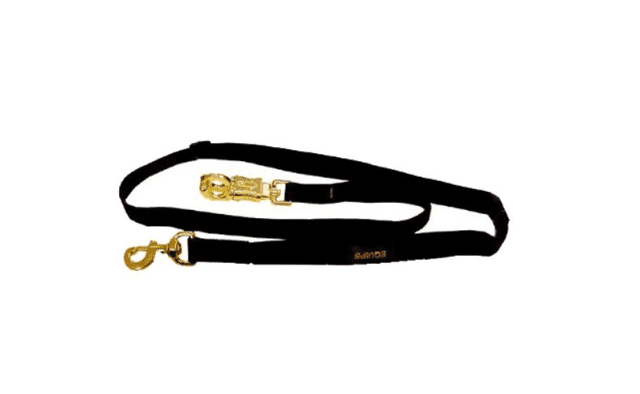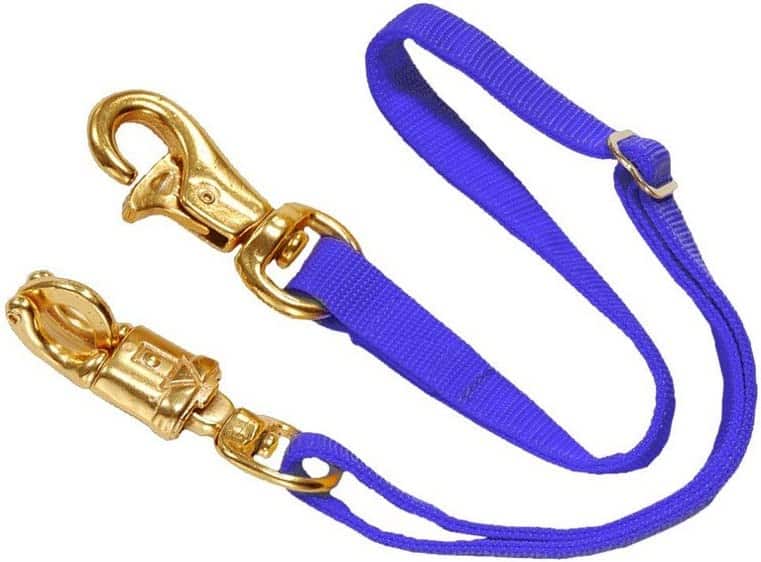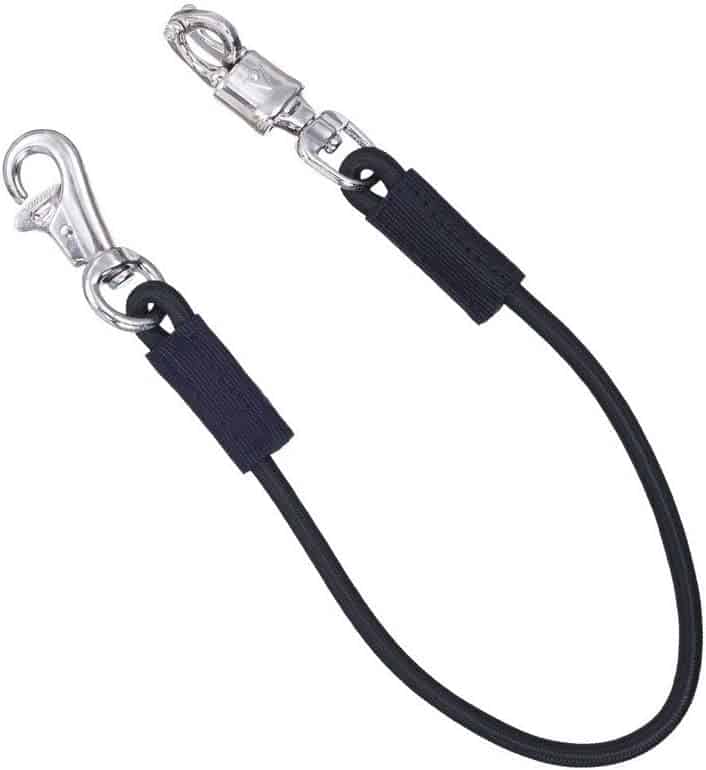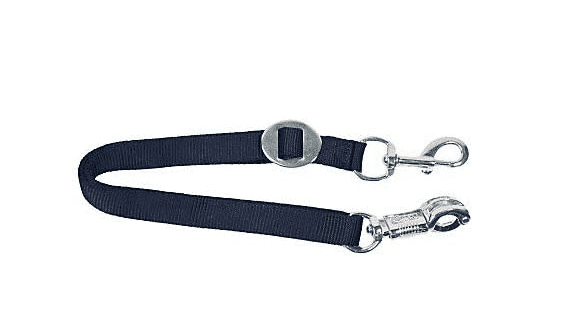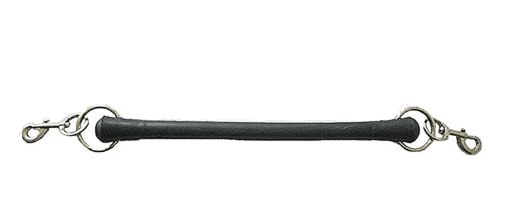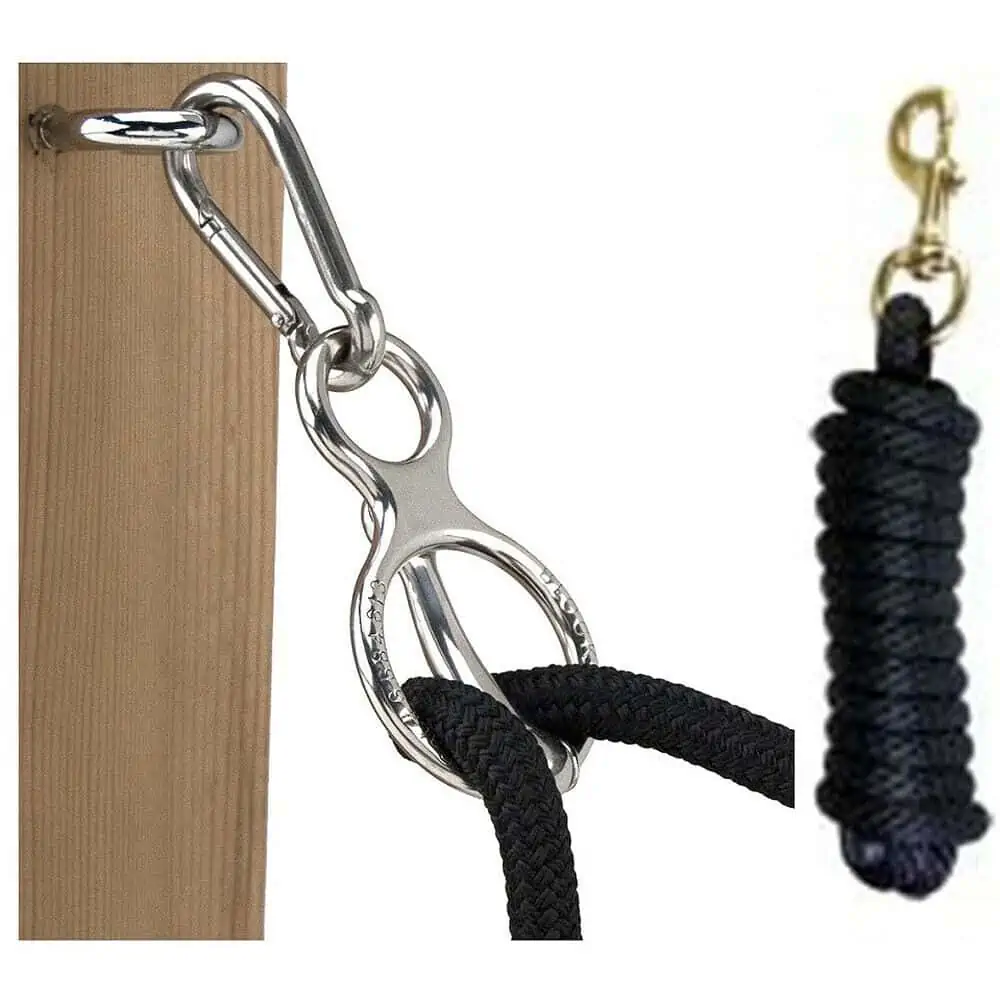- What is a Gaited Horse - October 5, 2023
- What to Look at When Getting a New Farrier - September 21, 2023
- Best Horse Feeds for Older Horses - September 21, 2023
- Trailer Ties Bottom Line Up Front
- My Top Horse Trailer Ties at a Glance
- Tips & Advice for the Effective Use of Horse Trailer Ties
- Selection Criteria for the Best Horse Trailer Ties
- Horse Trailer Ties Recommendations
- 1. Overall Best Horse Trailer Tie
- 2. Best Budget Horse Trailer Tie
- 3. Most Effective Bungee Cord Horse Trailer Tie
- 4. Best Longer Length Horse Trailer Tie
- 5. Elasticated Horse Trailer Tying Rubber
- 6. External Horse Trailer Tie System
- FAQs
- The Final Tie
Recently, I relocated to a new smallholding, several states away from my horses’ current location. It would mean a good couple of hours in the trailer or horse transport truck. Safety is always a huge concern, so I began looking into trailer ties that would guarantee my horses’ safety if they panicked. Yet, these ties also needed to be secure enough to prevent injuries from turning in the trailer or reaching across the middle divider.
I wasn’t happy to just go for the latest fad tie, or whatever was cheap. My horses are my kids, and I wanted to be sure that I anticipated every eventuality and planned to avoid ANY potential injuries. If you’re like me, you want only the best for your equine babies. I’ve got the best trailer ties for you, and you can read about how I made my choices and the things I consider when selecting a good trailer tie.
It’s time to haul your horse, and you need the best trailer tie—it’s right here.
Trailer Ties Bottom Line Up Front
My new horse is a bit of a tough loader, and I didn’t want his first trailer experience to be negative. I chose the Tie Safe Adjustable Trailer Tie, which comes with a Velcro panel that splits the tie, so the horse is half attached to their halter if they pull back, while the other half remains with the trailer.
This trailer tie has an excellent design as you still have something by which to grab the horse when they break away. Best of all, your trailer tie doesn’t actually break, as you can simply fix the tie by placing the Velcro back together.
My Top Horse Trailer Ties at a Glance
- Overall Best Horse Trailer Tie: Tie Safe Adjustable Trailer Tie
- Best Budget Horse Trailer Tie: Tough 1 Adjustable Trailer Tie
- Most Effective Bungee Cord Horse Trailer Tie: Tough 1 Bungee Trailer Tie
- Best Longer Length Horse Trailer Tie: Gatsby Trailer Tie
- Elasticated Horse Trailer Tying Rubber: Horze Trailer Lead
- External Horse Trailer Tie System: The Hi-Tie Trailer Tie System
Tips & Advice for the Effective Use of Horse Trailer Ties
A horse trailer tie can be as simple as a piece of string if you have an easy loader who travels well. There are risks to a simple tie like this, as it doesn’t stop a fidgety horse from turning or freeing themselves, so you should tie them well.
The other end of the spectrum is a hard-tied nylon rope, which can cause serious harm to a horse that panics, pulls back, and falls. A horse that is tied hard and can’t break free is a dangerous animal, and hauling such a horse in your float or even on a horse truck can be dangerous for both humans and animals.
A horse trailer tie is a section of rope or cord that ties the horse to a secured rail or hook in the trailer, preventing the horse from turning around or dropping their head down too far and being unable to lift their head if it gets stuck. The trailer tie is supposed to break away if the horse is stuck without potentially harming the horse. The basic construction of a horse trailer tie is a length of cord or rope with a buckle or clasp on either side.
Buckles, snaps, fasteners, and heavy rope can all ricochet and hurt the horse if these should fling back at the horse when the tie breaks. Choosing a good quality horse trailer tie that is safe to use can make your trailering experience so much better.
How to Use a Horse Trailer Tie
Your first set of horse trailer ties arrives—great! Now what? A poorly fitted trailer tie is a hazard to both the handler and the horse. Selection considerations are so important that the next section of this article is fully devoted to these points.
Remember a few golden rules when selecting and fitting a horse trailer tie. Fitting a horse trailer tie requires that the tie be long enough that the horse can comfortably reach up to eat their hay from the hay net while also dropping their head down slightly as the net empties and hangs lower. The horse should be able to drop their nose to their knees to have a good sneeze if needed.
In the confines of a trailer, your horse may need to clear their airways from dust and hay, so being able to sneeze is essential to keep your horse healthy and happy. Some horses panic when they attempt to lower their head and find they cannot do so, leading to rearing.
Your horse trailer tie should also not be so long that the horse can turn in the compartment, put their head over the dividing panel, or step on the extra length of the tie, potentially causing them to panic.
How to Ensure Your Horse Trailer Ties Remain Safe to Use
Your horse trailer ties may be perfectly safe when you buy them, but poor maintenance can lead to safety concerns a few months down the line. Therefore, it is imperative to check your horse trailer ties for damage from rot, rodents, friction, rust, and excessive use.
Many trailer ties have a quick-release clasp on one end to help a panicked horse get free. While this works well, the release mechanism may fail as soon as the clasp becomes rusted or damaged. The result can be a broken clasp that may hit the handler or the horse, causing severe injury.
Aside from inspecting your horse trailer ties a few days before you need to use them to ensure they are safe for use on your horses, you need to store them safely and correctly.
Sound storage principles to store your horse trailer ties are as follows:
- Indoors to prevent damage from the elements. Sunlight, rain, and wind can seriously compromise the integrity of the trailer ties (regardless of the material these are made of).
- Not placing the trailer ties under any tension, such as hanging them with a heavy buckle or halter, which will pull the tie out of shape.
- Only store the trailer ties once thoroughly dry. Suppose your tie has gotten wet; air dry before storing it in a storage container.
Additionally, when your ties have been in storage a while and show season rolls around, it’s wise to inspect the clasps and buckles for any sign of rust or dryness if the clasp has a spring mechanism. Oil the clasps as needed, check the hooks for signs of metal fatigue, and replace any questionable hardware if needed.
Selection Criteria for the Best Horse Trailer Ties
When I realized how many different horse trailer ties are now available (as a kid, we just tied the horses with a piece of bailing twine and a regular nylon halter), I was amazed. However, with so many options, it’s really important to have a clear idea of what you need.
My list of criteria to help me choose the best horse trailer ties included:
Secure Construction
Horse trailer ties are made from nylon, rope, elasticated cord, leather, and more. The hardware can be steel, brass, or even nylon. The material needs to last and offer some resistance to prevent fidgeting while still meeting a horse trailer tie’s “break-away” purpose.
Functionality
A horse trailer tie is designed to break when the horse pulls forcefully. Any trailer tie that doesn’t do this is faulty and dangerous. When the trailer tie breaks, it shouldn’t become dangerous to the horse or anyone handling the horse.
Quick-release buckles that don’t release in time can become projectiles that can hit the horse and handler with a surprising amount of force. I ended up with a broken finger due to a buckle that didn’t release when it should have.
Therefore, if you can, try out a sample of the trailer tie at your local equine goods supplier, and test the quick release under pressure to see how easily it releases and what amount of ricochet is involved.
Safety
The operation of the horse trailer tie should be safe for both the horse and the handler. A trailer tie that hits the horse when it releases or one that doesn’t release is a recipe for disaster. All it takes is one bad trailering experience for your horse to refuse loading in the future.
Whichever horse trailer tie you choose, ensure it is safe for your horse, will perform its function correctly, and is not a danger to your horse in any way.
Length
The length of your trailer tie should be sufficient to allow the horse enough length to reach their hay and lower their head slightly to clear their airway, swallow, or cough. The trailer tie shouldn’t be so long that the horse can accidentally get tangled in it or turn in their bay on the horse trailer or horse truck. A trailer tie is also helpful to prevent the horse from reaching across to nip the neighboring horse.
Budget
We all operate on a budget (unless you’re a Kardashian), and a trailer tie is probably not high on your list of priorities, right? However, a good horse trailer tie is a valuable piece of equipment if your horse frequently travels, so invest in a good quality one, even if it costs you a little more.
Horse’s Nature
Knowing your horse will also give you a better indication of what type of horse trailer tie would work best on them. Not all horses respond well to being tied (even slightly), but they will travel happily with gentle pressure. Some horses need to feel “tied” even when the trailer tie can release.
When my horses were all loaded up in their horse truck stalls, I quickly noticed which of them were happy to feel a little more restricted and needed a “dental-floss” feeling on the trailer ties to prevent panic.
Horse Trailer Ties Recommendations
The horse trailer tie you choose will need to tick all your boxes (or as many as possible) to ensure your horse is well-tied and safe and your trailering adventures go smoothly.
1. Overall Best Horse Trailer Tie
The Tie Safe, Adjustable Trailer Tie by Equips, has proven to be my favorite when loading horses into trailers, floats, or trucks. The tie has the added benefit that if the horse panics and pulls back, the tie doesn’t break in the traditional way. Instead, the Velcro straps separate, leaving one half of the tie on the horse’s halter and the other half on the trailer hook.
The added benefit of this kind of tie is that your horse has something to catch and lead them with on their halter if they should break away and run off.
Pros
- Separation is “soft” since there’s no buckle that can break, preventing snap back and injury
- It has a regular buckle and panic or quick-release clasp in case the Velcro fails
- Accommodates a range of horses with an adjustable tie length of 29 to 34 inches
Cons
- Clever horses can learn to pull back on the soft tie since there’s minimal resistance
- Velcro can become damaged if not cleaned regularly, losing its stickiness
I had absolutely no issues using this tie to secure my horses in their stalls on the horse truck. My gelding, a typical Nosey Parker, did manage to pull away when we were offloading, but since he still had a section attached to his halter, I could easily lead him back to the truck and reattach his end of the tie to the other end.
2. Best Budget Horse Trailer Tie
If you’re strapped for cash, have a lot of horses to load, or don’t want to spend a lot on trailer ties, then the Tough 1 Adjustable Trailer Tie is ideal for you.
Pros
- Low cost at $10.66
- Available in five different colors
- Flat polypropylene strap; double stitched for strength
- Adjustable with slide buckle
- Quick release for emergencies
Cons
- The nylon strap is stiff, making adjustment difficult
- 18 to 36 inches, but with adjustment, it may be too short for short ponies
3. Most Effective Bungee Cord Horse Trailer Tie
The bungee-type horse trailer tie is very popular, and the Tough 1 Bungee Trailer Tie is a good buy if this is what you prefer to tie your horses in the trailer. Many different types of bungee cord trailer ties are available, but the Tough 1 is reliable and very user-friendly.
I have even used this particular trailer tie to teach a young horse to tie. The cord offers enough resistance to discourage youngsters from pulling back. It is also strong enough to prevent the cord from separating without any need.
Pros
- Made from nylon elasticized cord
- Trigger bull snap on one end and a quick release clasp on other
- 29 inches long
- Available in six colors, including black, red, royal blue, and hunter green
Cons
- The same danger of a snap-back action that comes with a bungee-type tie where the buckle can become a projectile that can injure a horse or handler
4. Best Longer Length Horse Trailer Tie
The Gatsby Trailer Tie offers a little more adjustability if you need more extra length than the other types of trailer ties.
Pros
- Available in six colors
- Nylon strap of 1 by 20 to 30 inches in length
- Durable
Cons
- The buckles can become damaged over time, leading to injury if not first inspected.
5. Elasticated Horse Trailer Tying Rubber
You sometimes want to ensure your horse can stretch their neck, but you don’t want them to get their head right around in the trailer. The Horze Trailer Lead offers a non-break, elasticated option that appeals to some not-so-easily panicked horses.
Pros
- Solid rubber core with snaps on either end
- Stretches moderately
- Two sizes available: 28.3 and 38 inches
Cons
- Horses that panic may rip the snaps lose, causing injury
6. External Horse Trailer Tie System
If you are trailering your horse, you are likely competing with them. Competitions come with long waits, and you’re probably looking for an external tying system when a trailer tie won’t work. The Hi-Tie Trailer Tie System offers a solution for tying your horse outside the trailer without them pulling, panicking, or breaking free.
Pros
- Horses gain access to a 13 feet diameter area where they can graze without stepping on a lead
- The space provided allows rolling, lying down, and other movements in reach of the tie
- Made from stainless steel and fiberglass
- The bar folds away when not in use
Cons
- The arm requires an extra length bungee tie, which can still snap if the horse really tries to run off
FAQs
Answer: Yes, tie a horse in a trailer to prevent injury due to them turning in their stalls or to stop one horse from biting another.
Answer: Horse trailer ties should be a minimum of three feet long from one end to the other if there is a buckle or release clasp at both ends. A longer tie risks the horse being able to step on the rope or extra cord between the buckles. The horse may end up getting tangled or partially turning in their stall.
Answer: Horses should be tied at the same level as their chest or shoulders in a trailer to allow them space to eat hay, sneeze, and lower their head slightly if needed. Never tie a horse lower than the point of their shoulder, as this can lead to the horse panicking if they try to reach up.
The Final Tie
Horses can be flighty animals, and it’s up to you as a horse owner to use equipment that can calmly reassure them, without giving them something to pull back on and possibly causing themselves injuries. A trailer tie is a valuable piece of equipment if you have trained your horse to it.
When applied correctly, a trailer tie can help secure your horse in a trailer and prevent injury. I also caution against using just any tie as a faulty or incorrectly fitted tie can cause serious injury. Check out our guide on essential horse equipment for more information on additional horse gear and equipment.



